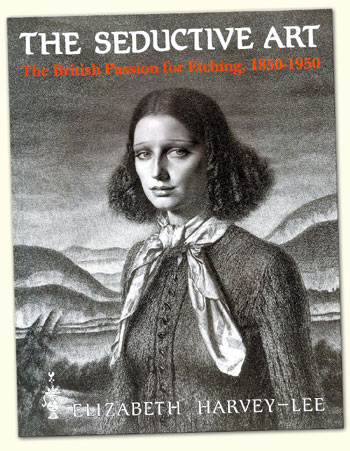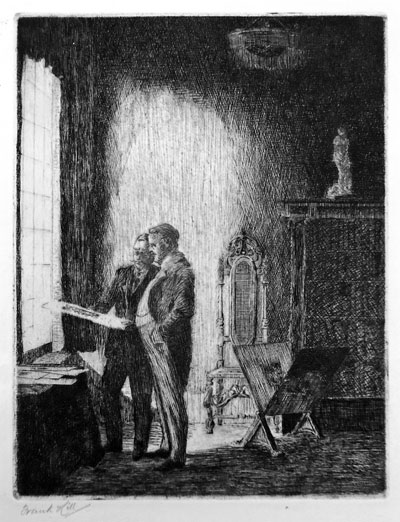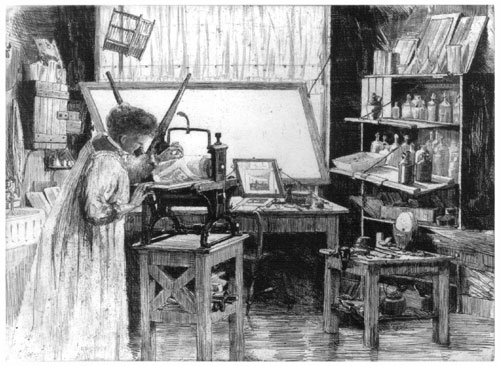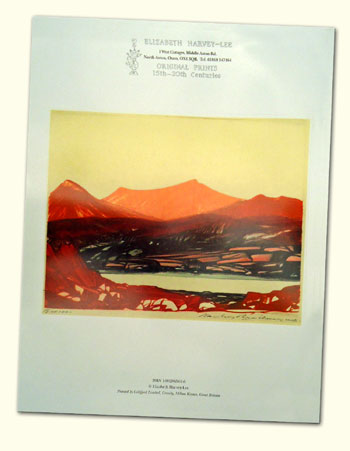|
THE
SEDUCTIVE ART
 |
The
British Passion for Etching 1850-1950
A
visual summary of a century of British etching
through the Etching Revival and Boom years.
Produced
in the form of a stock catalogue, with entries
for 350 artists, organised by ‘school’ and
association, in chronological sequences.
A
Preface (reproduced below) is followed by 25 ‘chapters’,
each generally with a short introductory essay.
The titles of these ‘chapters’ are
listed below under the heading Contents. |
Contents
Forerunners & immediate
Precursors: The Etching Club
The Founding Fathers – Whistler, Haden and
their Circle
Foundation and early years of the Royal Society of
Painter-Etchers (R E)
Early Members of the R E 1880-1900 – Minor
Etchers
Early Members of the R E 1880-1900 – Pioneers
of the Modern British etching Tradition
Non-Members of the R E 1880-1900
Slade students under Legros 1876-1892
Royal College of Art students under Short 1891-1924
Slade students 1892 to the Great War
The Sickert Circle – Pupils of Sickert
Bolt Court students 1910-1915
Independent etchers 1900-1920
The Naturalists – Etchers of Birds 1900-1930
Birmingham Friends
The 1920’s. The height of the Etching Boom
Slade students 1920-1930
Independent etchers 1920’s-1930’s
Royal College of Art students under Osborne & Austin
1924 -1940
Goldsmiths’ College Group
Rome Scholars
Painters who take up etching in the Boom years of the
1920’s
Wood Engravers who also engraved on Copper in the Boom
years
Minor etchers of the Boom years 1920’s-1930’s
The Last Generation. New etchers & engravers 1930-1950
Scottish Etchers 1890’s-1930’s
Colour Etching 1890’s-1940’s
End Word
Appendices
The Society of Graphic Art
The Society of Graver Printers in Colour
Bibliography
Index of Etchers
THE SEDUCTIVE APPEAL OF ETCHING
Surprisingly,
as early as 1710 in Susannah Centlivre’s
play 'The Man is Bewitched', Lovely’s invitation
to Maria to withdraw together to another room, is cloaked
in the propriety of viewing a collection of prints
in a connotation that anticipates the more recent ‘line’ “Come up and see my etchings ”.
However,
this memorable if somewhat dubious expression was
born of the very genuine passion for etching prevalent
at the end of the 19th century and in the early decades
of the 20th. Hugh Walpole in his novel 'Portrait of
a Man with red Hair' captures this intense period enthusiasm
in the following exchange.
Have you ever felt the collector’s passion
yourself ?
I
have always loved prints very dearly, etchings
especially … Etchings
are intimate and individual as is no other form of graphic art. They are so
personal that every separate impression has a fresh character. They are so
lovely in soul that they never age nor have their moods …
Frank
Short, a seminal figure in the British Etching Revival
and Boom, expressed the pleasure of sharing prized
etchings with friends in a booklet for the Royal
Society of Painter-Etchers in 1911. Short’s
description of a palpable sensual delight in physically
handling etchings as well as an emotional and intellectual
response to the images finds a visual equivalent
Frank Hill’s
drypoint "The Etching Connoisseur" (catalogue
item 606, see below).

The
especial delight in prints…that the collector
knows – comes of that intimate intercourse with
the pet proof… (with) prints of your very own
that you take out of their solander case or portfolio;
prints you hold tenderly in your hand, turn into various
lights, and lift from the mount to enjoy the very feel
of the paper: proofs that you have learned line by
line, and yet in which you are always finding new meaning.
Short
wrote both as a collector and as an artist practitioner
of etching. His sensuous delight in etching was shared
by other artists. Samuel Palmer acknowledged his pleasure
in the medium.
O!
the joy – the colours and brushes pitched
out of the window; plates…got out of the dear
little etching cupboard…needles sharpened three-corner-wise
like bayonets.
The
artist Hubert von Herkomer was even more explicit …
twenty
times and more did I give up etching and twenty
times and more did I take it up again. I have burned
holes with acid in my clothes, and holes in my skin;
I have spoiled carpets and had inflamed throats from
pouring over the fumes; I have sat up half the night
with a plate that would not come out right, and had
finally abandoned; I have taken plates to my
bedroom and worked at them half undressed, then gone
to bed and had frightful dreams about them. I have
neglected all duties in the dog-days of my etching
career, have made my family miserable and ill by
filling the whole house with bad fumes; and yet I
live to say that I love etching with all my heart
and soul.
Whistler’s initiation into etching, described
by a fellow young draughtsman at the U S Coast & Geodetic
Survey conveys the etcher’s excitement in the
practical technicalities.
Mr
McCoy, one of the best engravers in the office, went
over the whole process with us – how to
prepare the copper plate, how to put on the ground,
and how to smoke dark, so that the lines made by a
point could be plainly seen. For the first time since
his entry into the office, Whistler was intensely interested… Having
been provided with a copper plate…and an etching
point (needle), he started…his first experiment
as an etcher… After he had finished etching,
I watched him put the wax preparation around the plate,
making a sort of reservoir to hold the acid as McCoy
had instructed, Then he poured the acid on the plate,
and together we watched it bite and bubble about the
line…
A
sensuous interpretation equally pervaded etching
scholarship. Martin Hardie, Keeper of Prints at the
Victoria & Albert Museum, compiler of the catalogues
of several etchers’ work and a keen amateur etcher
himself, in his inaugural lecture to the newly founded
Print Collectors’ Club in 1921, contrasted the
characteristics of the two greatest formative influences
on British etching in the boom years of the 1920’s,
Rembrandt and Whistler, in the following analogy.
I
regard them as the Jupiter and Venus, largest and
brightest among the planets in the etcher’s heaven – Rembrandt
the Jupiter, because he is the more forceful and masculine,
with a brain powerful and masterful, penetrating in
its perception of character, wide and deep in its emotions;
Whistler the Venus, because, with all his mastery of
the medium, his significance of expression, he has,
in a marked degree, the predominant feminine qualities
of intuition, quick insight, delicacy, refinement,
daintiness – shall we say, too, of charming unexpectedness
and caprice?
THE PARTICULARLY BRITISH ENTHUSIASM FOR ETCHING
In
1862, when the Etching Revival was scarcely under
way, the French poet and art critic, Charles Baudelaire,
commented on the British craze for etching.
Professional artists had founded The Etching Club in
1838 and amateurs such as Queen Victoria and Prince
Albert indulged an interest. But it was from the 1880’s
that British artists’ and collectors’ involvement
with etching really escalated. P G Hamerton published
books and periodicals devoted to etching; Francis Seymour
Haden founded the Royal Society of Painter-Etchers
and established annual exhibitions of members’ etchings.
Etching was introduced into the curriculum of the recently
established London art schools, the Royal College of
Art and the Slade.
The
popularity of etching in Britain reached its zenith
in the second half of the 1920’s , when literally
hundreds of artists engaged in it. An ancillary 'Print
Collectors’ Club' had been set up by the Royal
Society of Painter-Etchers; periodicals such as Print
Collector’s Quarterly kept contemporary etching
in the public’s awareness with illustrated articles
and catalogues raisonnés of etchers’ work
to date. From 1923, for over a decade, Malcolm Salaman
published the annual 'Fine Prints of the Year', which
illustrated fifty new British etchings each year. The
booming market encouraged established painters and
sculptors not trained as etchers to take up the technique.
In
the case of the leading etchers of the day, such
as D Y Cameron, Muirhead Bone, James McBey or Arthur
Briscoe, demand outstripped supply. Editions were
fully subscribed to in advance, so that on publication
impressions could be re-sold immediately at auction
for several times the original subscription price.
By the end of the decade this intrusion of adverse
speculative interest in the print market inevitably
brought about its crash (not helped by the parallel
crash on Wall Street). Many artists stopped etching
when the market disappeared but the continuing allure
of etching as a creative technique still held some
artists in sway through the 1930’s till a more
final hiatus caused by the Second World War. Indeed
Gerald Lesley Brockhurst’s
masterpieces, "Adolescence" and "Dorette", among the
most outstanding images of the modern British etching
tradition, were etched in the early 1930's after
the crash.
A GOLDEN ERA
The
century 1850 – 1950 represents a golden
era in British etching. An instantly recognizable ethos
pervades the works but each artist’s contributions
to the canon carry an autographic individuality like
a personal handwriting. Exponents of an essentially
monochrome art, with the emphasis on the expressive
qualities of line and tone, the etchers of the period
had superb drawing skills. Their etchings reward literal
close study; magnification reveals an abstract microcosm
of lines, flicks, crosshatchings that to the distance
of the naked eye resolve into the familiar town scene,
landscape, marine, animal, bird or figure study or
portrait. Never before or since have so many artists
in a single country at a single period practised the
art of etching. Equally remarkable is the number of
women among their number. Item 149 in the catalogue
(see below), a self-portrait at the press by Constance
Pott (assistant to Frank Short in the engraving school
at the Royal College of Art) gives a fascinating view
of a woman examining a proof as it come off the press
amid all the paraphernalia of the etching studio.

STYLISTIC CONSIDERATIONS
Etching
evinces a flowing graphic line set off by telling
blank intervals but equally has the potential through
a network of crosshatched lines to create a rich,
painterly chiaroscuro of tone. Commensurately it
can be a spontaneous gesture in which the subject
is drawn from nature directly onto the plate, or
a highly finished transcription of a previously worked
out composition. The diversity of approach in Rembrandt’s
plates as his style evolved over the years provided
examples of both alternative approaches. While the
etchers of the 1920’s Boom years availed themselves
freely of both conventions, the pioneers of the etching
Revival, Whistler and Haden, advocated linear immediacy,
which they considered ‘true’ etching as
opposed to the ‘false’ etching of the
highly finished tonal plate worked over its entire
surface. Haden also worked in pure drypoint, Rembrandt
again supplying the model. Drypoint was much favoured
by succeeding generations of British etchers. Aquatint,
unknown to Rembrandt and only invented towards the
close of the 18th century, was rarely used, despite
earlier strong English associations. Although Rembrandt
was the single greatest stylistic influence on modern
British etching, it was contemporary French etching
which instigated the new direction British etching
took in the 1850’s. Whistler and Haden had close
contacts with Parisian etching circles and were instrumental
in the moving to London of Legros permanently and Tissot
for a decade, as well as the visits of the French printer
Auguste Delâtre. The etchings of Millet and Meryon
would influence later generations of British etchers.
 HOW
THIS CATALOGUE IS ORGANISED HOW
THIS CATALOGUE IS ORGANISED
The arrangement of the catalogue is roughly chronological,
both overall and within the subsections; the chronology
based on the period when an artist took up etching
rather than the specific dates of the individual items
included. This system is necessarily subject to anomalies
being determined by examples available in my stock.
Many etchers worked through several decades and may
be represented here by an etching carried out twenty
or thirty years after they first started etching.
Where it seemed appropriate, groupings of artists
have been determined by the institution at which they
trained, or according to ethos or friendship, or even
lack of affiliation. As by coincidence several of the
leading etchers were Scots by birth or association,
they have been removed from the general chronological
sequence and included together in a separate section
at the end of the catalogue.
Published 2001 to celebrate the new millennium
384 pages. Entries for 350 artists, organized by ‘school’ and
association in chronological sequences. 783 items described.
830 illustrations in black and white.
(UK
Price: £30, International orders: £35)
^ Return to the top of this page ^
FURTHER
INFORMATION on
an entry in The
Seductive Art
Confusingly there
are two artists called Eric Newton, near contemporaries,
and in The Seductive Art catalogue I have
compounded them.
The
two prints illustrated in the catalogue are by Ernest
Eric Newton,
but the biographical information given in the catalogue
is for another Eric Newton. For further information
please visit the dedicated website for Ernest
Eric Newton.
|